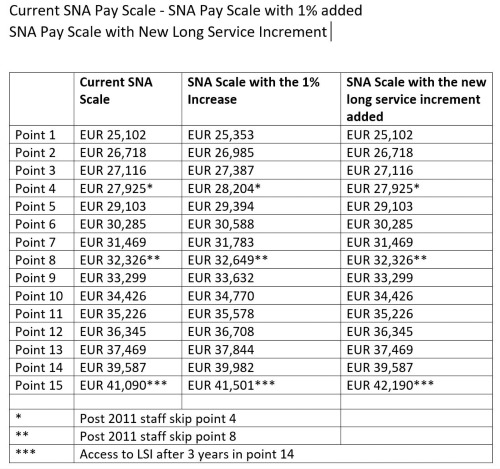Dear Colleagues,
You will shortly receive details on how to cast your vote in a consultation ballot that will make an important determination on new pay measures affecting 12,000 SNA members. This bulletin sets out those measures, explains how they have come about, and their value to SNAs.
The current building Momentum pay agreement provides pay increases in three stages. The first increase was paid in October 2021 as either a 1% increase on pay scales or €500, which ever was larger. A second 1% increase on pay scales is due from February 2022, (this increase could be replaced by claims for specific grades, categories or groups), and a final increase of 1% on pay scales, or €500 - whichever is larger - is due later this year in October 2022.
Therefore the pay increase due in February this year could be delivered either as a 1% increase to the SNA pay scale, or the same amount of money could be used to address outstanding claims for improvements to terms and conditions.
The Education Executive Committee decided to try and negotiate an option for SNAs which would improve pay at the top of the SNA scale, by adding an additional pay point as an alternative to accepting the 1% increase due in February. If negotiations were successful our SNA members would be able to choose either to accept the 1% increase to all the pay points on the SNA scale or, alternatively, to accept the additional increment in a ballot of all SNA members.
An increased LSI
Negotiations with the Department of Education have resulted in a proposal to replace the current 'long service increment' (LSI) on the SNA pay scale with a new increment that is €1,100 higher than the current maximum. This new increment would be permanent and pensionable. All SNAs who are currently on the existing long service increment (of €41,090) would automatically then progress to the new scale maximum of €42,190 from February 2022.
There are currently some 5,300 SNAs on the existing LSI. This option means that all of them would benefit immediately from the extension of the SNA pay scale.
We have chosen not to lengthen the SNA pay scale by adding an additional long service increment to the top of the scale, due to the fact that SNAs would have to wait on point 14 for three years to access the first LSI, and then wait another three years to access the second. That would have meant waiting six years from the last automatic increment (point 14) before members would benefit from the increase in earnings.
By replacing the existing long service increment with a more valuable increment, the scale is extended by €1,100, and members on the existing LSI can access the benefit immediately, regardless of how much time they have spent on that pay point.
The increase would be permanent. This means every SNA who progresses beyond point 14 on the scale will benefit in future years, and the new pay point will be pensionable and will count towards pension benefits.
The value of the new LSI is determined by calculating the number of SNAs at the top of the pay scale and then setting the value of the increment to ensure the cost falls within the maximum limit of €6.5m (the equivalent to increasing the pay scale by 1%). Fórsa and the Department of Education would monitor the costs of implementation, with scope to negotiate increases to the value of the increment ensuring that the value is maintained at 1% of the pay bill in future years.
Options
The alternative option that members can vote to accept is the standard 1% pay increase to all points on the SNA pay scale effective from February. This is a very straightforward option, and examples of the effects of both options on the pay scale are set out for reference below.
This is the first time that Forsa has secured an option to increase SNA earnings separate from the pay increases provided for the public sector as a whole. If the new increment is accepted, SNA maximum earnings would increase by 2.68%, rather than 1%, with a further €500 increase due in October 2022 taking maximum earnings in the SNA grade to €42,690. A total increase of 5.2% over the lifetime of the current pay agreement which ends on 31st December 2022.
SNAs have always been paid on the same scale as clerical officers. Should the additional increment be accepted, the SNA scale would be nearly €700 higher than the maximum of the clerical officer scale, meaning that SNA pay will move above maximum earnings for clerical officers for the first time.
The effects of both options are set out below for reference. I also enclose a list of Frequently Asked Questions which may address some of the queries you might have on this proposal.
Your branch will be holding information meetings to explain the details, so please try and attend one of those meetings if you remain unsure of how this will affect you in 2022 and in the future.
You will receive (via email) a link to log-on to a secure site to cast your vote electronically in the consultation ballot that will determine if the proposed new increment - or the 1% pay increase - is accepted by a majority of our 12,000 SNA members.
Yours Sincerely,
Andy Pike
Head of Education
09.02.2022
Please click HERE to access our Frequently Asked Questions document.
